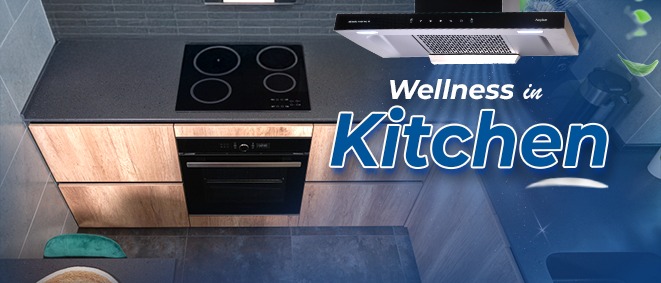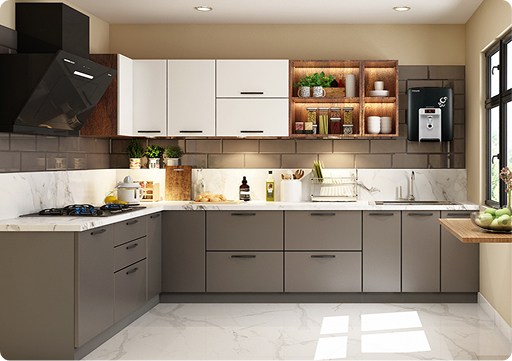KUTCHINA MAGAZINE
Wellness in the Kitchen

Updated on : 4th Jun, 2025
In our fast-paced, hyper-connected world, the kitchen can serve as more than just a place to prepare meals—it can become a sanctuary for self-care. While self-care is often associated with bubble baths, meditation, or spa days, it also finds deep roots in everyday rituals, especially those that involve food. Reimagining your kitchen as a space for nourishment—not just of the body but of the mind and spirit—can lead to a more grounded, mindful, and healthy life.
1. Optimise Kitchen Organisation with the Help of the Latest Storage Accessories
No matter what size your kitchen is, it’s understandable that keeping it well-functioning, calm, and clutter-free can be challenging. Clever kitchen organisation minimises stress and can improve cooking efficiency by making tools and ingredients easily accessible. Here’s how to optimise your kitchen using the latest storage solutions:
A. Pull-Out Pantry Systems
Modern pull-out pantry units allow easy access to dry goods, spices, and cooking staples without rummaging. These vertical sliding units fit into narrow spaces and fully use tall cabinets.
Ideal for: Small kitchens, awkward corners, or replacing cluttered shelf pantries.
B. Soft-Close Corner Carousels & Magic Corners
Forget wasted corner space! Magic corners or carousel units rotate and pull out smoothly, making deep cabinet corners fully usable. No more forgotten pots and pans in hard-to-reach areas.
Ideal for: L-shaped or U-shaped kitchens with blind corner cabinets.
C. Drawer Dividers & Modular Organisers
Customisable dividers for cutlery, utensils, and spice jars keep drawers neat and intuitive. Bamboo or metal modular systems allow you to reconfigure layouts as your needs change.
Ideal for: Creating calm, clutter-free drawer spaces that reduce decision fatigue.
D. Under-Shelf Hanging Baskets & Racks
These clever add-ons instantly double shelf space in cabinets. Hang baskets under shelves to store mugs, wraps, or plates, or use hooks for cups and cooking tools.
Ideal for: Maximising vertical space in cabinets and open shelving units.
E. Tiered Lazy Susans & Rotating Organisers
Perfect for corner cabinets, countertops, or inside the fridge, these rotating trays keep condiments, oils, and jars visible and accessible.
Ideal for: Deep cupboards or frequently used cooking stations.
F. Over-the-Door and Under-the-Sink Organisers
Don’t overlook hidden spaces! Over-the-door caddies and under-sink pull-outs can store cleaning supplies, foil rolls, dish towels, or recycling bags.
Ideal for: Utility items, reducing clutter around the sink area.
G. Stackable, Transparent Storage Bins
Clear acrylic or BPA-free plastic bins stack easily in fridges, freezers, or cabinets and let you see what you have at a glance. Label them for extra clarity.
Ideal for: Meal prep zones, fridge organisation, and reducing food waste.
H. Vertical Plate Holders & Pan Lids Racks
Use vertical racks to keep baking trays, chopping boards, and pot lids upright. These reduce clutter, prevent scratches, and make everything easier to grab.
Ideal for: Deep drawers or under-oven storage.
I. Smart Labelling
Pairing traditional labels allows you to track expiry dates, stock levels, or recipes linked to ingredients.
Ideal for: Bulk pantry storage and tech-savvy home chefs.
J. Dedicated ‘Wellness Station’
Designate one drawer or cabinet as your self-care zone—store herbal teas, supplements, reusable water bottles, calming snacks, or your favourite mug. Add a soft-close drawer and organisers to make it a soothing daily ritual.
Ideal for: Supporting mindful eating and intentional daily habits.
2. Create a Calming Kitchen Atmosphere by Choosing the Right Kitchen Colour
The colours surrounding us deeply influence how we feel, and the kitchen, often the emotional core of the home, is no exception. When you choose colours that promote calm and comfort, your kitchen becomes a more peaceful, restorative place—an actual self-care space.
Here’s how to select kitchen colours that support serenity and wellbeing:
A. Soft Neutrals: The Foundation of Tranquillity
Shades like ivory, warm beige, taupe, and soft grey create a timeless and restful backdrop. These colours help declutter the visual field and provide a gentle canvas for daily kitchen rituals. They pair beautifully with wood, linen, and natural stone.
Ideal for: Minimalist kitchens, open-plan spaces, and those who find calm in simplicity.
B. Gentle Greens: A Touch of Nature Indoors
Green is known for its grounding and restorative qualities. Sage, olive, or soft mint echo the natural world, evoking freshness and harmony. These tones are perfect for creating a kitchen that feels connected to the earth and health.
Ideal for: Wellness-focused homes, plant-filled spaces, and lovers of nature’s palette.
C. Warm Whites and Creams: Light Without Harshness
A soft white or buttery cream reflects light beautifully without the sterility of stark white. These tones brighten the kitchen while feeling soft and inviting, making them perfect for small or low-light spaces.
Ideal for: Compact kitchens, vintage-inspired homes, or cosy cottages.
D. Avoid Overly Bold or High-Contrast Schemes
While bright reds, oranges, or sharp blacks can be dramatic and modern, they often stimulate rather than soothe. Opt for balance and softness in your palette if you aim for a kitchen that supports mindful cooking and relaxed energy.
Pro Tip: Balance Colour with Texture
When you incorporate texture, like wooden shelves, linen curtains, matte ceramics, or woven baskets, a neutral kitchen can feel warm and engaging. These tactile elements bring depth and cosiness to your colour scheme.
3. Cook with Presence and Intention
Mindful cooking is a powerful act of self-care. Instead of treating meal prep as a chore, engage all your senses. Feel the textures, notice the aromas, and listen to the rhythm of your chopping or the sizzle in the pan. Cooking this way can become meditative, grounding you in the present moment.
Try cooking without distractions—put away your phone or turn off the TV—and allow the experience to be fully immersive.
Often seen as the heart of the home, the kitchen can also become the heart of your self-care practice. When you treat food preparation and nourishment as acts of love and attention rather than obligations, the benefits ripple outward—into your mood, energy levels, digestion, and relationships.
Whether you're simmering soup on a Sunday or sipping tea as the sun rises, remember: every act of care in the kitchen is an act of care for yourself.
- Nita Bajoria, Creative Director, Kutchina
Trendings













